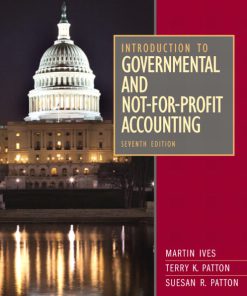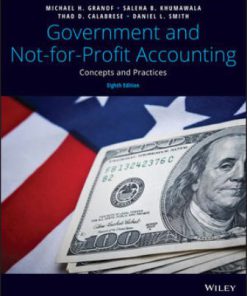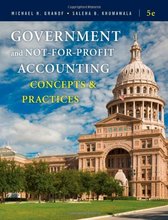Test Bank for Government and Not-for-Profit Accounting 8th by Granof
$35.00 Original price was: $35.00.$26.50Current price is: $26.50.
Test Bank for Government and Not-for-Profit Accounting 8th by Granof
Test Bank for Government and Not-for-Profit Accounting 8th by Granof

Product details:
- ISBN-10 : 1119495857
- ISBN-13 : 978-1119495857
- Author: Michael Granof
Government and Not-for-Profit Accounting highlights the dynamic nature and constant evolution of the field and the intellectual challenges it presents. Designed to assist both preparers and potential users of financial reports, this book emphasizes concepts over rules and regulations to help students think critically and consider the effectiveness of alternate methodologies. Real-world examples demonstrate the similarities and differences between the public and private sectors–and how each might approach the same issue–and complete coverage of relevant reporting standards and practices aligns with the latest GASB, FASB, and AICPA changes. A central goal of this text is to make students aware of the reasons behind the guidelines and standards, and consider their strengths, limitations, applications, and alternatives. Much more than simply an invaluable preparation resource for the CPA and CGFM exams, this book lays the intellectual foundation that allows the students of today to become the leaders of tomorrow: the members of the standardsetting boards, partners of CPA firms, government and notforprofit executives, legislative and governing board members, and more.
Table contents:
- CHAPTER 1: The Government and Not-for-Profit Environment
- HOW DO GOVERNMENTS AND NOT-FOR-PROFITS COMPARE WITH BUSINESSES?
- WHAT OTHER CHARACTERISTICS OF GOVERNMENTS AND NOT-FOR-PROFITS HAVE ACCOUNTING IMPLICATIONS?
- HOW DO GOVERNMENTS COMPARE WITH NOT-FOR-PROFITS?
- WHAT ARE THE OVERALL PURPOSES OF FINANCIAL REPORTING?
- WHO ARE THE USERS, AND WHAT ARE THE USES OF FINANCIAL REPORTS?
- WHAT ARE THE SPECIFIC OBJECTIVES OF FINANCIAL REPORTING AS SET FORTH BY THE GASB AND THE FASB?
- DO DIFFERENCES IN ACCOUNTING PRINCIPLES REALLY MATTER?
- WHO ESTABLISHES GENERALLY ACCEPTED ACCOUNTING PRINCIPLES?
- SUMMARY
- KEY TERMS IN THIS CHAPTER
- QUESTIONS FOR REVIEW AND DISCUSSION
- EXERCISES
- CONTINUING PROBLEM
- PROBLEMS
- QUESTIONS FOR RESEARCH, ANALYSIS, AND DISCUSSION
- CHAPTER 2: Fund Accounting
- WHAT IS A FUND?
- WHAT ARE THE KEY ELEMENTS OF GOVERNMENT FINANCIAL STATEMENTS?
- WHAT CHARACTERIZES FUNDS?
- HOW CAN FUNDS BE COMBINED AND CONSOLIDATED?
- WHAT ARE THE MAIN TYPES OF A GOVERNMENT’S FUNDS?
- WHAT’S NOTABLE ABOUT EACH TYPE OF GOVERNMENTAL FUND?
- WHAT’S NOTABLE ABOUT EACH TYPE OF PROPRIETARY FUND?
- WHAT’S NOTABLE ABOUT EACH TYPE OF FIDUCIARY FUND?
- WHAT IS INCLUDED IN A GOVERNMENT’S COMPREHENSIVE ANNUAL FINANCIAL REPORT (CAFR)?
- HOW DO THE FUNDS AND ANNUAL REPORTS OF NOT-FOR-PROFITS DIFFER FROM THOSE OF GOVERNMENTS?
- SUMMARY
- KEY TERMS IN THIS CHAPTER
- EXERCISE FOR REVIEW AND SELF-STUDY
- QUESTIONS FOR REVIEW AND DISCUSSION
- EXERCISES
- CONTINUING PROBLEM
- PROBLEMS
- QUESTIONS FOR RESEARCH, ANALYSIS, AND DISCUSSION
- SOLUTION TO EXERCISE FOR REVIEW AND SELF-STUDY
- CHAPTER 3: Issues of Budgeting and Control
- WHAT ARE THE KEY PURPOSES OF BUDGETS?
- WHY IS MORE THAN ONE TYPE OF BUDGET NECESSARY?
- HOW ARE EXPENDITURES AND REVENUES CLASSIFIED?
- WHY ARE PERFORMANCE BUDGETS NECESSARY?
- WHAT ARE THE KEY PHASES FOR THE BUDGET CYCLE?
- ON WHAT BASIS OF ACCOUNTING ARE BUDGETS PREPARED?
- WHAT CAUTIONS MUST BE TAKEN IN BUDGET-TO-ACTUAL COMPARISONS?
- HOW DOES BUDGETING IN NOT-FOR-PROFIT ORGANIZATIONS COMPARE WITH THAT IN GOVERNMENTS?
- HOW DO BUDGETS ENHANCE CONTROL?
- WHAT ARE THE DISTINCTIVE WAYS GOVERNMENTS RECORD THEIR BUDGETS?
- AN ALTERNATIVE METHOD: CREDITING OR DEBITING THE DIFFERENCE BETWEEN REVENUES AND EXPENDITURES TO “BUDGETARY CONTROL”
- HOW DOES ENCUMBRANCE ACCOUNTING PREVENT OVERSPENDING?
- ARE BUDGETARY AND ENCUMBRANCE ENTRIES REALLY NEEDED?
- SUMMARY
People also search:
government and not-for-profit accounting concepts and practices 8th edition pdf
government and not-for-profit accounting concepts and practices 8th edition
not-for-profit accounting example
canadian accounting standards for not-for-profit organizations
non for profit accounting standards
government and not-for-profit accounting
You may also like…
Test Bank
Test Bank for Core Concepts of Government and Not-for-Profit Accounting, 2nd Edition, Granof,
Test Bank
Test Bank for Government and Not-For-Profit Accounting: Concepts and Practices, 7th Edition
Solution Manual
Government and Not-for-Profit Accounting Concepts and Practices Granof 6th Edition Solutions Manual
Solution Manual
Test Bank
Test Bank for Government and Not for Profit Accounting Concepts and Practices, 5th Edition: Granof
Test Bank
Test Bank for Introduction to Governmental and Not for Profit Accounting 7th Edition by Ives
Solution Manual
Solution Manual
Solution Manual
Solution manual for Government and Not-For-Profit Accounting: Concepts and Practices, 7th Edition












